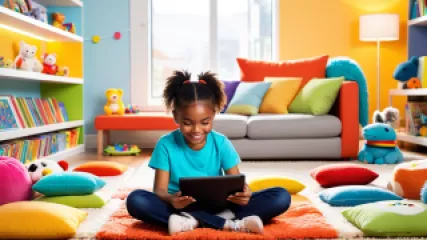10 Best Online Play Therapy Tools for Children
Exploring the World of Play Therapy
Play therapy is a powerful tool used by child therapists to help children express emotions, develop coping skills, and address psychological challenges. With the advent of technology, play therapy online has become increasingly popular, offering a plethora of tools and resources that can be accessed from the comfort of home.
This article delves into the 10 best online play therapy tools for children, each designed to enhance therapeutic play activities and support child therapy techniques. Whether you're a professional therapist or a parent seeking to assist your child's emotional well-being, these tools offer innovative ways to engage and heal.
1. Virtual Sandtray App
The Virtual Sandtray App is an excellent tool for replicating the traditional sandtray therapy experience. It allows children to create scenes using various virtual objects, fostering creativity and expression.
- Key Features: Wide range of virtual miniatures, customizable backgrounds, and interactive elements.
- Benefits: Enhances storytelling and helps children articulate their feelings in a non-verbal way.
- How to Use: Children can drag and drop items into the sandtray, creating scenes that represent their thoughts and emotions.
“The Virtual Sandtray App has revolutionized my practice. It’s a fantastic way for children to express themselves when words fail.” Nestor Sandoval, Licensed Therapist
2. GoZen!
GoZen! offers a variety of therapeutic play activities aimed at reducing anxiety and boosting resilience in children. Their programs are rooted in positive psychology and delivered through engaging animations and interactive sessions.
- Key Features: Animated videos, interactive exercises, and printable worksheets.
- Benefits: Teaches coping strategies and emotional regulation in a fun, accessible way.
- How to Use: Children can watch animated stories and participate in activities designed to build emotional strength.
“GoZen! has been a game-changer in helping my child manage anxiety. The animated stories make complex concepts easy to understand.” Aurora Bell, Parent
3. Mightier
Mightier combines biofeedback with video games to help children learn emotional regulation. By wearing a heart rate monitor, children see their physiological responses and use calming techniques to control the game.
- Key Features: Biofeedback integration, engaging video games, and real-time heart rate monitoring.
- Benefits: Teaches self-regulation and coping mechanisms in an interactive format.
- How to Use: Children wear a heart rate monitor while playing games that respond to their emotional state, encouraging them to practice calming techniques.
“Mightier has helped my son understand his emotions and learn how to manage stress effectively.” Adalyn Reyes, Parent
4. Smiling Mind
Smiling Mind offers mindfulness and meditation programs geared towards children and adolescents. These guided sessions are designed to reduce stress, improve focus, and enhance overall well-being.
- Key Features: Guided meditations, mindfulness activities, and user-friendly app interface.
- Benefits: Promotes mental clarity, emotional balance, and relaxation.
- How to Use: Children can follow along with guided meditations and mindfulness exercises tailored to their age group.
“Incorporating Smiling Mind into our daily routine has significantly improved my daughter’s focus and calmness.” Jimmie Cunningham, Parent
5. Breathe, Think, Do with Sesame
This interactive app from Sesame Street teaches problem-solving and emotional regulation through fun, engaging activities. Children help a Sesame Street monster navigate everyday challenges, learning valuable skills along the way.
- Key Features: Interactive problem-solving scenarios, familiar Sesame Street characters, and engaging animations.
- Benefits: Builds problem-solving skills and emotional intelligence.
- How to Use: Children guide the monster through various challenges, practicing breathing exercises and thoughtful responses.
“Breathe, Think, Do with Sesame is a wonderful tool for teaching young children how to handle emotions constructively.” Nestor Sandoval, Licensed Therapist
6. MyLife Meditation
MyLife Meditation (formerly Stop, Breathe & Think Kids) offers personalized mindfulness and meditation exercises based on the user’s emotions. This app helps children develop self-awareness and emotional resilience.
- Key Features: Emotion-based activity recommendations, guided meditations, and progress tracking.
- Benefits: Enhances emotional awareness and promotes relaxation.
- How to Use: Children choose how they’re feeling, and the app suggests appropriate mindfulness activities.
“MyLife Meditation has been instrumental in helping my child identify and manage her emotions effectively.” Aurora Bell, Parent
7. SuperBetter
SuperBetter uses game mechanics to build resilience and improve mental health. The app turns everyday challenges into quests, empowering children to develop a growth mindset and tackle obstacles with confidence.
- Key Features: Game-based resilience training, personalized quests, and social support features.
- Benefits: Fosters a positive mindset and enhances coping skills.
- How to Use: Children complete quests and challenges designed to build resilience and promote mental well-being.
“SuperBetter makes personal growth feel like an adventure. It’s a fantastic way for kids to build emotional strength.” Adalyn Reyes, Parent
8. Inner Explorer
Inner Explorer provides daily mindfulness practices for children, designed to be used in both school and home settings. These audio-guided sessions help children cultivate focus, emotional regulation, and overall well-being.
- Key Features: Daily guided mindfulness sessions, classroom implementation support, and age-appropriate content.
- Benefits: Improves focus, reduces stress, and enhances emotional resilience.
- How to Use: Children listen to daily mindfulness sessions, practicing techniques to stay present and calm.
“Inner Explorer has been a valuable addition to our classroom, helping students stay focused and calm throughout the day.” Nestor Sandoval, Educator
9. Cosmic Kids Yoga
Cosmic Kids Yoga offers a fun and engaging way for children to practice yoga and mindfulness. Through interactive videos, children embark on imaginative adventures that integrate yoga poses and mindfulness exercises.
- Key Features: Interactive yoga adventures, mindfulness exercises, and themed episodes.
- Benefits: Enhances physical health, promotes relaxation, and boosts emotional well-being.
- How to Use: Children follow along with yoga adventures, practicing poses and mindfulness techniques.
“Cosmic Kids Yoga makes exercise and mindfulness fun and accessible for children of all ages.” Jimmie Cunningham, Parent
10. Mood Meter
The Mood Meter app helps children identify and track their emotions, promoting self-awareness and emotional literacy. By understanding their feelings, children can better manage their reactions and communicate effectively.
- Key Features: Emotion tracking, personalized feedback, and mood analysis.
- Benefits: Promotes emotional intelligence and self-regulation.
- How to Use: Children log their emotions throughout the day, receiving feedback and insights to help them understand their feelings.
“Using the Mood Meter has helped my child articulate his feelings and develop better emotional management skills.” Aurora Bell, Parent
The Benefits of Online Play Therapy Tools
Online play therapy tools offer numerous benefits, making therapeutic interventions more accessible and engaging for children. Here are some of the key advantages:
- Accessibility: Children can access therapy tools from anywhere, eliminating geographical barriers.
- Engagement: Interactive and gamified elements make therapy enjoyable and motivating for children.
- Flexibility: Online tools can be used at any time, allowing for flexibility in scheduling therapy sessions.
- Variety: A wide range of tools and activities cater to different needs and preferences.
- Parental Involvement: Parents can participate in activities, fostering a supportive environment for the child's growth.
Choosing the Right Tool for Your Child
Selecting the appropriate play therapy tool depends on your child's individual needs and preferences. Here are some considerations to keep in mind:
- Age Appropriateness: Ensure the tool is suitable for your child's age and developmental stage.
- Therapeutic Goals: Consider what you hope to achieve through play therapy, such as reducing anxiety or improving emotional regulation.
- Interests: Choose tools that align with your child's interests to enhance engagement and motivation.
- Ease of Use: Opt for user-friendly tools that are easy for both you and your child to navigate.
- Professional Guidance: Consult with a licensed therapist to determine the best tools for your child's specific needs.
By carefully selecting the right tools, you can maximize the benefits of play therapy and support your child's emotional and psychological well-being.
Integrating Play Therapy Tools Into Daily Routine
Incorporating play therapy tools into your child's daily routine can enhance their effectiveness and foster consistent emotional growth. Here are some tips for seamless integration:
- Set a Schedule: Designate specific times for play therapy activities to establish a routine.
- Create a Comfortable Space: Ensure your child has a quiet, comfortable environment for engaging in therapeutic activities.
- Be Consistent: Regular practice is key to achieving therapeutic goals.
- Involve the Family: Encourage family participation to create a supportive atmosphere.
- Monitor Progress: Keep track of your child's progress and adjust activities as needed.
Consistency and a supportive environment are crucial for the success of play therapy. By integrating these tools into your child's routine, you can help them develop essential skills for emotional well-being.
The Future of Play Therapy
The evolution of technology continues to shape the future of play therapy, offering new possibilities for intervention and support. Here are some trends to watch for:
- Virtual Reality: VR technology can create immersive therapeutic experiences, enhancing engagement and effectiveness.
- Artificial Intelligence: AI-driven tools can offer personalized therapeutic interventions based on real-time data.
- Teletherapy Integration: Combining online tools with teletherapy sessions provides comprehensive support for children.
- Data-Driven Insights: Advanced analytics can help therapists track progress and tailor interventions to individual needs.
- Global Accessibility: Online tools can reach children in remote areas, providing much-needed support where traditional therapy may not be available.
As technology advances, the landscape of play therapy will continue to evolve, offering innovative solutions to support children's mental health and emotional development.
Conclusion: Empowering Children Through Play Therapy
Online play therapy tools provide a dynamic and engaging way to support children's emotional and psychological well-being. From virtual sandtrays to interactive mindfulness apps, these tools offer diverse therapeutic play activities that can be tailored to individual needs.
By leveraging these resources, parents and therapists can create a nurturing environment that fosters growth, resilience, and emotional intelligence in children. As we embrace the potential of technology in play therapy, we open new doors to healing and empowerment for the next generation.
Remember, the journey of play therapy is unique for every child. With the right tools and support, children can navigate their emotional landscapes and emerge stronger, more resilient, and ready to face the world with confidence.






